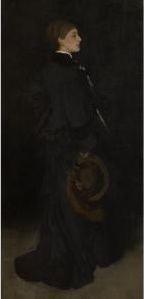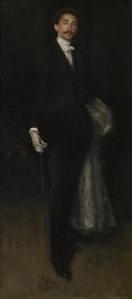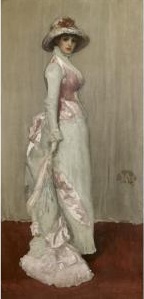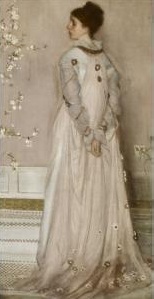August 23, 2012
I recently visited the Frick Collection, the legacy of the late-19th/early-20th century art collector Henry Clay Frick, on display in his mansion. The Frick Collection has many fine paintings, but the four Whistlers (James Abbott McNeill Whistler, 1834-1903) in the East Gallery caught my attention in an uncommon way. They were in the company of an eclectic mix of El Greco, Goya, David, Manet, Degas, Renoir, Corot, Reynolds, and others. Frick arranged paintings to his capricious liking (the museum endeavors to remain true to his intent), and this results in a curious mix. However, the four long, vertical Whistler portraits stand as pillars in the four corners of the gallery, acting as architectural anchor points and adding unity to the gallery.
 |
 |
 |
 |
| Arrangement in Brown and Black: Portrait of Miss Rosa Corder | Arrangement in Black and Gold: Comte Robert de Montesquiou-Fezensac | Harmony in Pink and Grey: Portrait of Lady Meux | Symphony in Flesh Colour and Pink: Portrait of Mrs Frances Leyland |
Whistler was a Tonalist, using a restrained pallet dominated by muted greys and browns, and a simple design with the figures and set blending together in a common atmosphere. In the dark portraits of Corder and Montesquiou-Fezensac, the figures barely emerge from the shadowy background. Similarly, in the light portraits of Meux and Leyland, the women blend with the pale walls behind them. Light or dark, the effect is the same: the subjects meld with, recede into, and evolve out of the background. The result is a profound harmony.
Whistler believed that the purpose of painting was not to convey moral lessons, as would say a Neoclassical painter; instead, it should exist for its own sake. In each of these portraits the subject is presented without sentiment. The virtues and failings of the subjects are indiscernible, and no lesson is taught.
Viewing an individual Whistler differs from viewing a collection of them. When I see four of these portraits together (and I have never encountered four Whistlers arranged together before), they begin to look formulaic. They are all full length portraits, the subjects sharing a ramrod straight posture, and viewed from the same perspective. That harmony begins to look like caution, the emotional distance like rejection.
If only one of these paintings had been hung in the gallery, it would have been as dominant as any painting there. But here the uniformity of the four, and their placement in the corners, relegated them to architectural elements. The acclaim of the individual Whistlers was sacrificed, and necessarily so, to allow the gallery to pleasantly and successfully display such a broad mix of styles.
